In June 2022, we finished the first 3D sketches of our four new guitar pick models. However, the picks weren’t 100% ready.
The thickness, size, and even the names of the picks were still undefined.
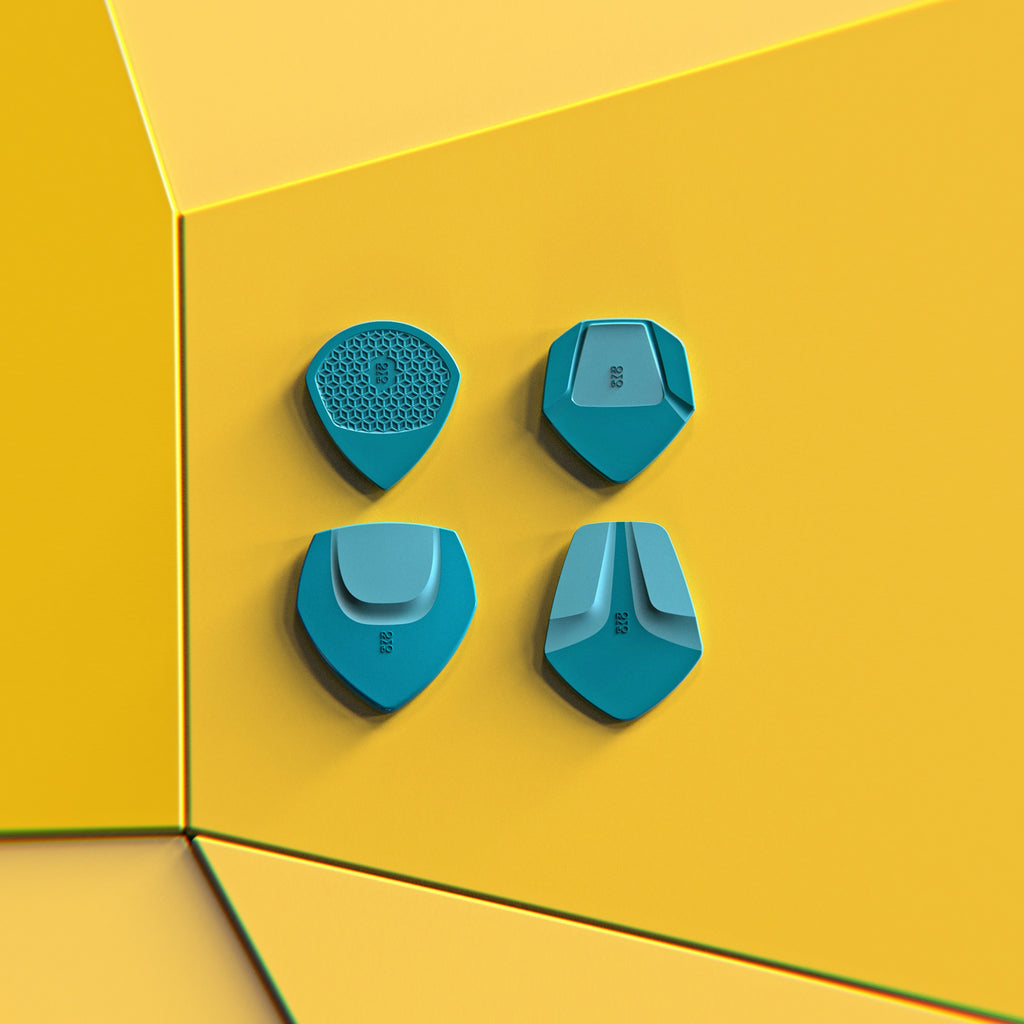
We decided to take the approach of involving as many guitarists as possible to help us co-design our new guitar picks.
The aim of this article is to summarize the results of the survey that 2122 guitarists completed. These people directly influenced the final design of our picks.

The guitar community has strongly supported Rombopicks since its beginning in 2019.
We did not want to create new guitar picks without asking the people who have been with us since the beginning. You all are the core of Rombo, and you should decide which products we develop.
The most logical step was to create a big survey, allowing users to tell us how they prefer their guitar picks. We think this is the only way to develop a product based on the wants of our users, allowing us to make essential decisions about our company's direction.

This is only possible by listening to the thoughts of every guitar player.
2122 guitar players participated in the survey and, therefore, have taken part in the design process of these new guitar picks for 2023.
509 of them left a private message with detailed information.
We discuss these private messages below.



There is a clear winner. Guitar pick number 2 is the favorite for most people.
Could it be because of its similarity in shape and size with the iconic jazz iii guitar pick?
Surprisingly, number 4 is the guitar pick that surprised me the most during the
prototype test. But of course, you never know until you try it!

Name:
Average Thickness: 0,66 mm
Size: Small Size with 89% of the votes

Name:
Average Thickness: 0,953 mm
Size: Medium Size with 77% of the votes

Name:
Average Thickness: >2 mm
Size: Large Size with 55% of the votes

Name:
Average Thickness: 0,72 mm
Size: Medium Size with 85% of the votes

A total of 509 people left us a private message regarding guitar picks.
We have read all of them carefully and we will use all this information during the
development stage.
Here are the top 10 questions we have repeatedly received and our comments on them:
● Will the guitar picks be available in different colors?
Yes! The launch will include all regular Rombo colors.
Other “special edition” colors are in the pipeline.
● Will they have the same grip structure?
Lots of people have sent us e-mails and letters regarding the grip structure. With the micro-nodules, we have the advantage of medium-grip surfaces which add lots of control.
However, a very small number of people want the picks to have more grip. We had to make a decision here, and it was hard. We will slightly increase the “grain density” on the textured areas, so there are more “micro-nodules” per square millimeter.
This way, we hope to satisfy the needs of all groups.
● The material is cool but it produces warm and mellow tones. I prefer
bright tones. Do you plan a new material range?
We have intentionally created our compound in order to reach those mellow tones. However, about 12% of the users reported preferring bright tones.
We have decided to start the research on a new material that will be launched as an extra range as soon as we find the correct formula. The expected date for the launch of the new material is early 2024.
● Why don’t you create different guitar pick thicknesses for each one
of the models?
We want every guitar pick to be unique. As every person has individual preferences, we believe every guitar pick should have its own design. In the future, we hope to be able to create a wider range of plectrum designs to cover each possible necessity.
● What about picks for bass players?
Most of our picks are compatible with bass, as we have confirmed this with some bassists that are using them regularly, especially Rombo Diamond and Rombo Origami. We explained this HERE.
● You should create some merch, T-Shirts, and other stuff:
Maybe in the future. Now, we want to focus 100% on the development of the guitar picks. Every minute we spend on the design of a T-Shirt will be taken away from the quality of the picks! ;)
● Will you offer the EcoBlack range in other colors?
The EcoBlack material can only be produced in one color at the moment.
The recycling process creates a very dark pigmentation. The industry is working hard to find a way to create new recycling processes. We hope we will manufacture all of our picks out of recycled material in the future.
● Why don’t you create boutique picks?
Counter question: What is a boutique guitar pick?
A boutique pick is a unique piece of art with the shape of a guitar pick that you can use for guitar playing. Usually, these picks are handmade and out of exotic materials. They contain some artistic elements like ornament geometries and usually they are unique special edition pieces with elevated starting prices.
Our approach is different. We create boutique-like guitar pick designs at very affordable prices. Otherwise, there would only be a couple of Rombo designs available for the most influential pick collectionists.
We think, this way, we found a niche in the middle of mass production picks and single special editions. With this approach, we bring the boutique feel to a larger number of people, reinforcing the guitar pick community and the awareness of this small but important accessory.
● Some picks I ordered in 2019 had burrs. This is not a problem for
playing but it doesn’t look cool.
We have good news for you. In 2021, we developed a new method to manually remove the burrs from the picks. This means that all Rombo picks are manually revised and processed to remove all the visual aspects that don’t belong to the original design (like small burrs on the border).
This cost us extra time but as a premium brand, we need to keep improving our quality standards to make sure your guitar picks are as good as your expectations!
● Why Kickstarter again?
See below :)
The new guitar picks will be launched in spring 2023.
If you want to receive an E-Mail as soon as the picks are available, join our
mailing list (see the footer).
This is the timeline we created for this project:

Kickstarter campaigns turn dreams and ideas into reality. Rombo is still a small start-up run by two people, and with limited access to resources. Through Kickstarter, we involve the community of guitar players, showing our guitar picks before launching.
This process brings us in contact with the real guitar players. It forces us to remain flexible, accept changes, and it challenges us to create new designs to fulfill the expectations of our audience.
We love open and critical criticism, and this is the best place to get it, where all comments and thoughts are visible. By sharing your experiences, we can listen to your needs and wishes, and create guitar picks that make a difference.
Medium guitar picks are the most popular choice amongst guitarists and they offer the best of both worlds, right? Well, it is not that easy.

In our last article, “thin vs thick guitar picks”, we discussed both guitar pick thickness ranges in depth. Medium guitar picks deserve a separate analysis.
Guitar pick thickness is usually measured in millimeters and this is an attribute that can change various aspects of a pick like flexibility, tone, volume, pick noise, durability, control over single notes, and more.

The thickness of a guitar pick is for this reason considered one of the 4 fundamental attributes of a guitar pick, along with guitar pick material, shape, and size.
Medium guitar picks range in thicknesses from 0.55 and 1 mm.
The following is what a survey performed in March 2021 has shown. Thousands of guitarists were asked to define the following pick thicknesses:
With both limits established, we obtain the thickness definition of medium guitar picks.

The maximum thickness of a thin guitar pick was defined as about 0.55 mm by 2.292 guitarists.
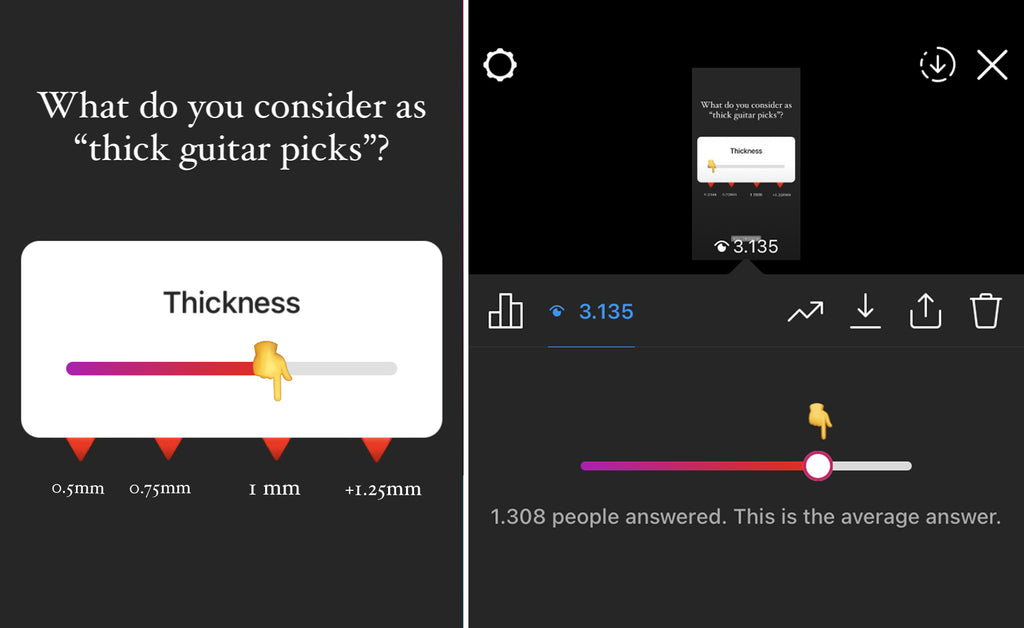
The minimum thickness of a thick guitar pick was defined as 1 mm by 1.308 guitarists.
Medium guitar picks are guitar picks with a thickness between 0.55 and 1 mm. These guitar picks are very popular because of their versatility; in some areas, they offer the advantages of both thin and thick guitar picks.

Medium gauge picks have the broadest flexibility range. In this pick thickness interval, the material will play the most important role when it comes to defining the flexibility of a pick.
In other words, thick guitar picks are always stiff and rigid. With thicknesses over 1 mm, even the most flexible pick materials are stiff, and therefore the material has less influence on the flexibility of the pick. This relation creates a broad flexibility range amongst medium guitar picks, which can be very flexible or very stiff, depending on the material used.

The same effect can be applied to tone, durability, and pick noise.
Typically, medium guitar picks are used by lead guitarists who also implement rhythm guitar techniques and look not only for an all-round compromise between single-note melodic phrases and strumming, but also potentially developing a more versatile guitar career that integrates different techniques and mixes both worlds together.
|
|
Thin guitar picks (under 0.55 mm) |
Medium guitar picks (0.55 - 1 mm) |
Thick guitar picks (over 1 mm) |
|
Flexibility |
Flexible/very flexible |
Medium flexibility or stiff, depending on the material. |
Rigid/very rigid |
|
Tone |
Lighter tones, less bass |
Warm tones for softer materials. Brighter tones for harder materials. |
Warm/dark tones and mellow tones |
|
Volume |
Maximum volume is limited. Lower dynamic range. |
Can provide high volume with the usage of hard materials. |
Provide high volume. Broader dynamic range. |
|
Guitar pick noise |
Noticeable pick noise |
Reduced pick noise when the pick has a variable thickness. |
Reduced pick noise |
|
Durability |
Less durable |
Depending on the material. |
More durable |
|
Control |
Less control for single notes |
Very versatile. Control of single notes is possible if the player is experienced with this type of pick. |
High control of single notes |
|
Popular techniques |
Rhythm guitar, strumming, tremolo picking, ... |
Very versatile. A combination of both thin and thick guitar picks is possible if the player is experienced with this type of pick. |
Lead guitar, shredding, sweep picking, ... |
|
Common type of players |
Beginners, acoustic guitar players |
Most popular thickness. Medium thickness is used by beginners, intermediate and advanced guitarists. |
Intermediate and advanced guitarists |
This makes medium gauge guitar picks the most difficult picks to estimate without having tested them, and it is one of the reasons why we created the “guitar pick parameters” included in every product page, like in Rombo Origami.

For most beginner guitar players, medium gauge guitar picks are the best option. You are in a process in which experimenting with sounds and learning new techniques will shape your profile as a guitarist in the future.
You might change your music taste during this process or even change your guitar type. You must stay flexible and versatile to allow your skills to develop in all directions and be a more rounded guitarist.
For this, a medium guitar pick is perfect, since you will be able to try different techniques with a pick that works very well in many different areas. After you have decided the direction of your development as a guitarist, increasing or decreasing the gauge won’t be that difficult.
Therefore, this is statistically the best option to start with if you want to try different guitar learning paths.

However, there are some exceptions: Some beginner guitarists know exactly what kind of player they want to be. They know from the very beginning if their dream is to become a very technical metal player, if they prefer being an expert acoustic guitar rhythm player, or if they will focus on songwriting and not on their guitar skills.
These examples are very rare, but they exist. In this case, you might want to consider starting with a guitar pick that has been designed for the type of skills you want to improve.
If you are a beginner, this might be interesting for you: Guitar pick for beginners
Rombo Origami guitar pick - 0.75 mm
Flexible but still rigid enough for note control. Right amount of flexibility for a snappy fluid attack that's bright and crisp. The concave surface on the hold area ensures ergonomic and comfortable hold.

Rombo Prisma guitar pick - 0.8 mm (available in September 2021)
A classic shape enhanced by modern surface technology. The geometry on the main body has different height levels for the most comfortable hold and grip.

Rombo Crisp guitar pick - 1 mm (available in September 2021)
Medium thickness combined with geometric concave design surfaces. The result? Unexpected flexibility with great bass tones. Its medium-sharp tip provides extra warm tones.

Each pick has a specific purpose, and you choose the pick based on the sound you want to achieve as well as other personal preferences like comfort and grip.
Medium picks are not just the picks in the middle of thick and thin guitar picks. They are a perfect approach for those guitarists looking to develop versatility and flexibility in their learning path.
Due to the high influence the material has on these picks, they are the most difficult picks to estimate before testing them, and every medium guitar pick is unique. Despite this, they are the best choice for most beginner guitarists.
However, if you have a very clear idea of the skills you want to develop in the future, you might be looking for either thin or thick guitar picks, which we discussed here.
Guitar pick noise can’t be avoided completely. Especially while recording acoustic guitar, plectrums tend to create a lot of click and clack sounds and noises that can ruin your playing experience as well as your listeners’.
As you learn how to play the guitar better, you will reach a point where you want to focus on transmitting emotion, playing with impact, and enhanced dynamic control.
In order to master your guitar techniques, you must have total control of every sound produced by your guitar; intended and unintended.

Personally, I think pick noise is a part of the guitar playing, and I even enjoy some vintage recordings where the guitar pick noise seems to be present almost on purpose. However, for most of the occasions, you want to eliminate it.
We have summarized all the tips and tricks we think can help you reduce the noise when playing with a guitar pick. Enjoy it!
Guitar picks create noise when plucking your strings. Holding your guitar pick more loosely will help a lot, since your fingers absorb some of the energy when the pick hits the strings.
We have published an article called “How to hold a guitar pick”, which contains everything you need to know to master this trick.

If you are recording your tracks, one thing that can help is to add some more volume to your instrument in relation to the others. This is a common method used in studios that helps the guitar players to relax.
Whether you are planning a studio session, a jam with your friends, or some solo relax sessions at home, a conscious warm-up before playing guitar is mandatory.

The angle of the guitar pick in relation to the strings is the most discussed element when it comes to guitar pick noise.
Basically, the less pick is in contact with your guitar strings, the less noise it produces. Angle the pick slightly to the strings.
Try different angles when plucking your string. This will require a conscious adjustment from your side, but once mastered will allow you to vary the attack of the pick more easily.
Depending on the guitar pick you are using, the music style and guitar techniques you use, and your skill level, you will need a different attack angle, so focus 30 minutes on trying to find the best one for you and get used to playing this way.
Sometimes you are playing and the flow starts, you mentally leave the room and enter “the zone”, that beautiful place where you sound better than usual.
We get so much into the music, that we just naturally pick harder.

Excessive picking force is one of the most common causes of guitar pick noise. In addition, it can choke out the sustain and cause the notes you are playing to decay in a much less natural way.
The material of the guitar picks not only affects the tone, but also the noise the plectrum creates.
Nylon is considered to be one of the least noisy formulas when it comes to industrial materials used for guitar picks.
This is due to the toughness of this compound, which thanks to its mechanical properties, is able to absorb heavy impacts efficiently.

At Rombo, we are using a modified version of nylon, which adds some extra durability and prolongs the lifespan of the guitar picks. This was necessary since nylon guitar picks wear down very quickly. You can learn more about the materials here.
If you are not sure if you are using the right guitar pick, a good option is a variety pack, which contains guitar picks with different attributes. This is a good way to test several picks and track your development as you start increasing your skill for each one.
As a rule of thumb, you can estimate that heavier picks will be less noisy, which sounds kind of contradictory. But, why is that?

Using very thin picks in combination with fast-playing, like strumming, will cause the picks to bend as they leave the guitar strings, creating a kind of click noise. This happens especially when playing acoustic guitar, since the body of the guitar will act as an amplifier for that sound.
Heavier picks will let each string make its own noise without much unwanted accompaniment.

The variable thickness, included in all our guitar picks, not only improves the control but also reduces the noise. The body of the plectrum is thicker and stiff, while the tip is thinner and more flexible. With this feature, the overall flexibility of the tip is reduced while conserving its original thickness and material. This means more control and less noise.
Thick vs. thin guitar picks. In this article, we discuss all the aspects that make a difference.
Guitar picks with a beveled edge will slide better and cause less noise. In combination with the angle of attack we already mentioned, they can help you reduce the pick noise a lot.
Also, the shape and size of the pick are important, but this is more a matter of preference.

We have frequently discussed the impact a polished tip has on the tone and durability of a guitar pick.
A polished tip also slides quite easily over the edge of the guitar string. On the other hand, guitar picks with a rougher texture on the tip, will produce more treble response even when played on the edge. This also happens when the picks start to wear down.

However, as mentioned at the beginning of the article, some purist guitarists even prefer the pick to create noises and they included it extra in their recordings.
Very experienced live players that don’t have much studio experience sometimes do not reflect enough on all the little nuances on their playing.

A good exercise to avoid this is to record yourself. It is amazing how much we miss when we get into the zone. You will notice pick noise when listening to your tracks and it is much easier to identify critical areas than while you are playing.
If you play acoustic guitar, try to locate the microphone(s) in different locations, you will discover how much of a difference it can make in terms of guitar pick noise.
We can’t eliminate pick noise completely, but there is enough to do to improve our playing and reduce it substantially.
The best way to reduce pick noise is to be aware of it and reflect on your playing to improve your skills and try different picks for different styles and guitar types.
If you discover a new way to reduce the pick noise, please let us know so we can include it in the article!
This article was created because you asked for it. It is meant to be as transparent as possible, so that you can see who the faces behind Rombo are and how we organize this project internally.
We hope you enjoy it!
Since 2019, Rombo has been researching surface finish and design in order to find the perfect balance between grip, ergonomics, and function in guitar picks and other guitar accessories. Rombo was born thanks to an amazing guitar player community whose aim is to continue this adventure and quest for the perfect guitar accessories.
We are Judith and Carlos, a happily married couple trying to innovate in the world of guitar picks. We live near Stuttgart, Germany.

We both love music, guitars, product development, challenges, and attention to detail, so Rombo was the perfect excuse to mix all these things together and have some amazing adventures.
From Remseck, near Stuttgart in Germany, we do almost everything.
Here, we receive the packaging and the dots we use to fix the guitar picks to the packaging. We try to be very organized and keep the place very tidy. Tidy places also look better for photographs!

In the shipping station, there is one tray for every guitar pick model. We also include a flyer and a “thank you”-card with every delivery. This way we make the experience more personal, while sharing our journey of packing your guitar picks directly with you!

We have a label printer, which is super useful, and thankfully our web system allows us to automate the printing for every customer and create a label with just one click.
Our post carrier receives the boxes from us with all the information they need to bring our products to you, including weight, countries, and import information for the customs.

We ship every order directly from our location.
The envelopes we use are not very cheap, but they protect the product well, they are made of 100% recycled paper and they are plastic free.

We have to be very multifaceted to cover all the tasks we do, from idea generation, product development, graphic design, photography, web maintenance, logistics, social media, packaging development, and accounting, to all the stuff a start-up involves.

We believe that doing everything by ourselves gives us a very close perspective from the customer side.
This means, when you ask something on Instagram or Facebook, you receive an e-mail from us, or we answer your comment. It is us behind the screen typing every word and every smiley!

We love walking a lot. We go for a walk for 5 kilometres almost everyday. Almost every idea we applied to Rombo was created while having a walk. We called it our daily inspiration walk.

Two years ago, at the very beginning of this journey, we could not have imagined how many things we needed to learn!
We have encountered many challenges on the way; for example, I remember it was very difficult to find out how to sell internationally and establish a system that is fast enough for us.

I cannot tell how many books on startups, online marketing, Kickstarter or time management we have read! One of the most useful ones was A Crowdfunder's Strategy Guide: Build a Better Business by Building Community, by Jamey Stegmeier.
A funny anecdote is that Judith and I don’t have our own Instagram profiles. For the first post from Rombo, we had to check out a tutorial on Youtube to try to understand the process. I am glad to say that two years later, we have reached almost 20K followers!
PS: We still don’t have our own accounts, the one for Rombo is enough work! :)
The most complex part is the design process of a guitar pick.
I like to sketch a lot, so I have lots of old ideas and sketches which I use as an inspiration source. Sometimes, we use questions to challenge the design process, like “Is it possible to create a guitar pick that is flexible and rigid at the same time?” While trying to answer this question, we came up with the idea of “variable thickness”, which has proven to substantially increase ergonomics.

Since we have an engineering & design background, we also do the modeling in 3D and product engineering. Every detail is important here to create high-quality products.

When we think the design is ready, we create some prototypes and send them to the testers. If you follow us on social media you will know some of the testers from our stories.
In total, we have about 30 guitar players that help us during this phase of the project and communicate with us which points they liked or didn’t like. Thanks to their feedback, we are able to improve areas of the guitar picks which we would otherwise not have thought of.
For the manufacturing of our guitar picks on a large scale, we use a technology called injection molding.

In this process, the melted raw material is injected into a mold with the negative shape of the guitar picks.
It is a very complex process with lots of engineering in it, the material has to be treated in a special way to keep the proper humidity, temperature and pressure, and to avoid external contaminations.

On the left, the injection mould from Rombo Diamond: Our polimer flows through the mould runner (yellow arrows) after it reaches over 270°C degrees and it is pushed forward.
The red area is the area we use for the grip texture. The blue area is high mirror polished.
On the right: The first ever produced Rombo Origami from 30.11.2018. The first 50 guitar picks we produced were sent to guitar pick testers who gave us feedback about the material, the grip, the tone and the shape.
The raw material we use is produced in Italy. We have worked very closely with our material partner to accomplish every requirement we had, including the 100% recycled material of the EcoBlack sets. If you want to know more about the materials we are using, you can find more information HERE.

We believe packaging is a very important aspect of a product. We not only use it to create an atmosphere and emphasize the quality of the product, but also to inform you about the attributes of our guitar picks.

This is the reason we created packaging with lots of printable areas to describe the guitar picks. We include our parameter bars, a short description of the guitar pick, the 6 special attributes of a Rombo guitar pick, and a QR-code with extra information.
We had a total of about 6 different concepts before we decided which one was the most suitable.
Right now, we are creating the packaging layouts for the new models that will launch in 2021. We have received some samples and they look great!


If you want to see the new models, you can click HERE.
Carlos takes the pictures for social media. We are not very skilled with the camera, but we have learned a couple of tricks and after thousands of trials, we are able to take decent pictures in our living room.

In our Instagram you can find the best pictures.
You have probably noticed that our posts on Instagram are mainly informative. Guitar picks are often underrated and most guitar players don’t think much about it.
However, guitar picks are the loudest amplifier you can have in your hands and are the bridge between you and your guitar.

We try to pass the know-how we have obtained directly to you, so you can make conscious decisions about the products you purchase. Aspects like the variations on the tone depending on guitar pick thickness, or why are there so many guitar pick shapes and materials… And this is the reason we created our blog articles.
Our aim is to create a communication process that goes back and forth between us. Some of you have become friends of ours and have won a new perspective of thinking about guitar picks.
“To listen closely and reply well is the highest perfection we are able to attain in the art of conversation.” – François de La Rochefoucauld, essayist.
We believe we have one of the most engaged communities ever! We try to answer every comment and every private message, and we are sure we have an answer rate very close to 100%.
You all have participated in surveys, and you have left amazing comments and reviews. You post stories regularly and we have had very deep conversations with some of you! Thank you!
We also received great support from many amazing blogs like Heavy Repping, Gigs and Guitars, The Gadget Flow, Ultimate-Guitar, Guitar World, and others.
Rombo is expanding. We are working with dealers around the world and currently we have sellers in the following countries:

This means, with the help of our dealers we are able to sell in Europe, North America, Asia, Australia, almost every country of South America, and South Africa.
Transparent communication with our dealers is a priority with us, and so far 100% of the new sellers stay with us! Together we are developing the brand and taking it to the next step.
During our inspiration walks, we talk about Rombo in the next few years. It is very difficult to imagine what the future will bring.
We would like to bring new designs (lots of them!), to increase the amount of recycled material for the manufacturing of the picks, or even be able to create colored recycled guitar picks. We want to talk more to our customers and share our experiences, and from time to time, share some great music and playlists.
We are only two people and every step takes its time. Some of you have written beautiful thank you letters to us or left very good reviews and we want to let you know that we are working hard everyday not to disappoint you :)
You are the best and you have a vote on the future of Rombo!
There are many annoying things in life, but there’s nothing more annoying than losing a guitar pick you just had in your hand, and then realize that it has disappeared forever!
The small size of the plectrums makes them easy to play with, but often difficult to keep.

The key to not losing guitar picks, is to start thinking of them as a vital piece of gear. Like a violinist would never lose their bow, or a drummer would never lose the drum sticks, you should never lose your guitar picks.
There are many methods below, that will prevent your guitar picks from getting lost.
Decide on a location for your pick, when not in use, and put it back where it belongs, when you put the guitar away.
Many players think of the guitar pick as disposable, and don’t place value on them. When you allow your guitar picks to lay around in random locations, it is not a surprise when your guitar picks get lost.
The container can be a glass, your guitar case, your wallet, or a handmade DIY case. Be original and don’t be afraid of using something unique.
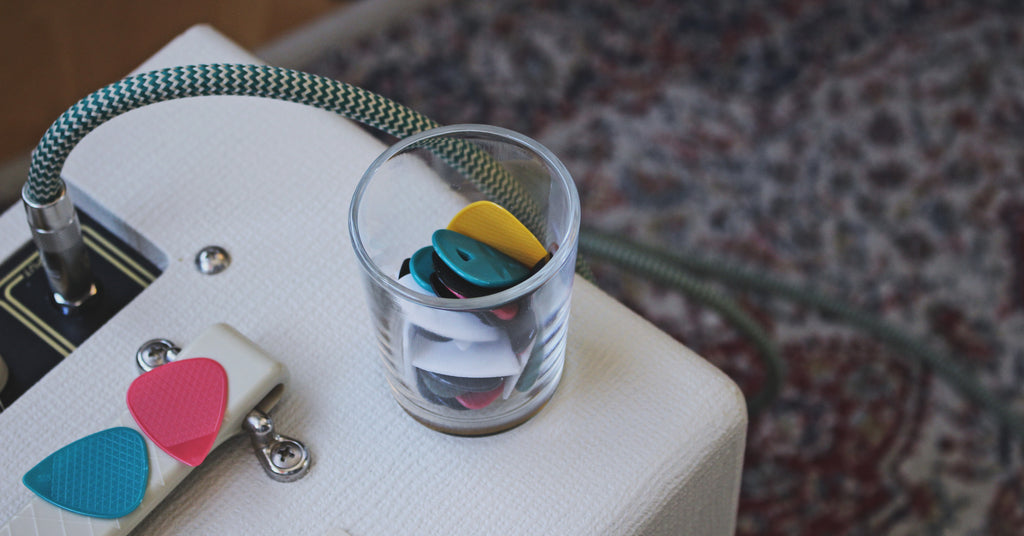
From time to time, there will be another guitar player who will need to borrow a guitar pick, especially during a tour, or live performance.
Sometimes the borrowed picks find their way back. However, often they walk off with the player and you never see them again.

Start thinking of picks as having the value they deserve and treat them that way. Do not hesitate to ask for your pick to be returned.
Like the container, this is an accessory that allows you to keep your guitar picks where they belong, in a known place.
In addition, in a live performance, a guitar pick holder can be used to store your picks during the songs that require fingerpicking, that do not require a pick.
It is the perfect guitar accessory for the live player who needs quick access to guitar picks anywhere and everywhere on the stage.
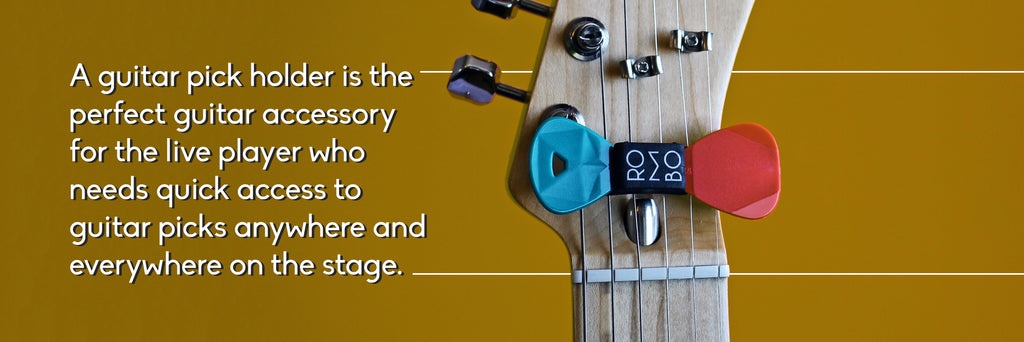
There are holders for the guitar neck and for the microphone stand. Some people create their own DIY holders with double-sided tape. This can work for a while, but has some disadvantages: The tape can lose it’s capacity to hold the pick over time, and the glue can damage the guitar surface.
If you are looking for an adhesive-free guitar pick holder click HERE.
As simple as it sounds. If you have played many years, you are probably storing your guitar picks in your pockets. This is the most common way to lose your guitar picks.
A day after playing guitar, you will use different jeans, with no guitar picks in your pockets...or even worse, you will do laundry with the picks inside your jeans, and your washing machine will eat them!
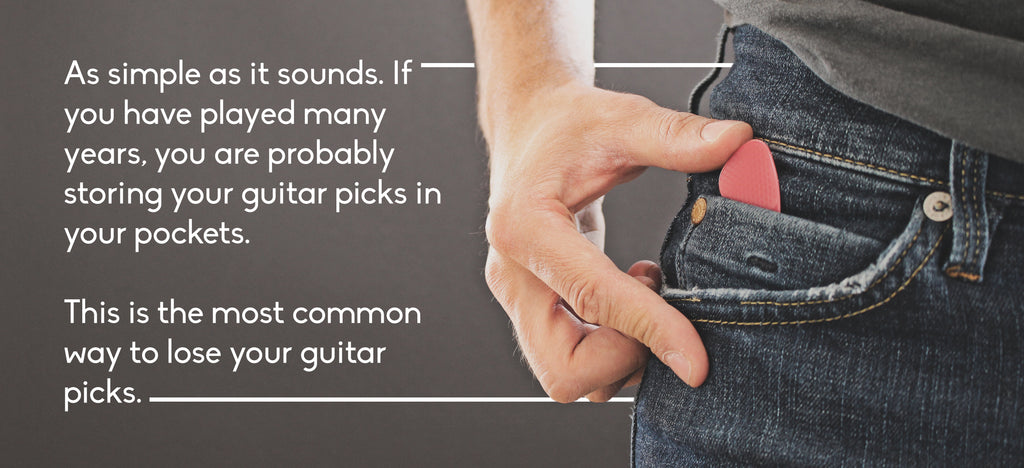
If you are very careful, you won’t need the following advice. But just in case this happens, we have some suggestions for you.

With this small checklist, you can easily find your guitar pick in a systematic way. But, what happens if this does not work?
If the guitar pick gets lost you can only do one thing: Hope you have some extra guitar picks!
It is important to have some additional unused guitar picks in a secure place. Before that, you have to decide which guitar picks types are essential for you, and at least have a pair of them for this emergency.
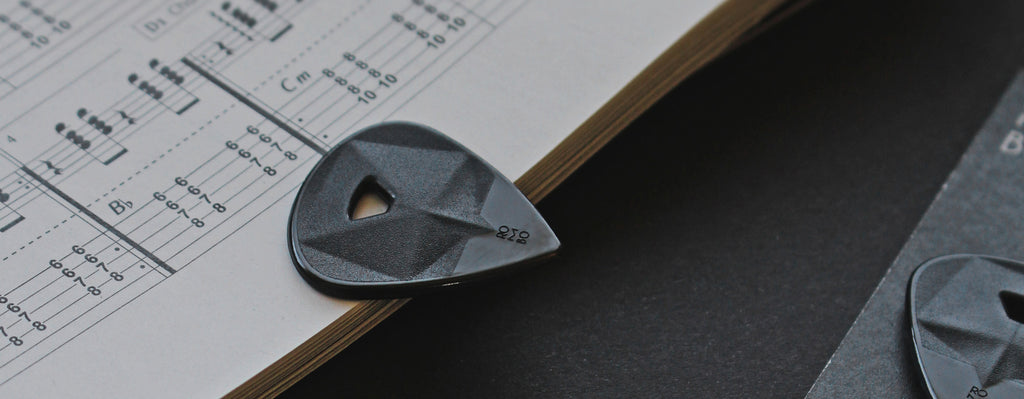
We have a guide to choosing the right guitar pick, which you can find HERE.
It can be very annoying to find out you cannot continue playing, because your guitar pick is gone, and having extra picks will save time, which you can use to practice guitar.
Do you know somebody who is always losing their guitar picks?
Please share this advice with them!
In case you are trying to learn the guitar, the first thing you need to know is how to hold a guitar pick the right way.
Guitar pick or plectrum is a small object that you hold in your hands and play the guitar strings. The quality of guitar you are playing depends mainly on the way you are holding its pick.
So, before you officially start learning guitar, you should learn to hold the plectrum in the right manner.

Mentioned below in this article are some of the tips and tricks which you can use for holding the guitar pick in your hand so that it doesn’t feel awkward and helps you in playing the guitar in the most suitable way.
The first and the easiest manner of holding a guitar plectrum is that you keep it in between your index finger and your thumb. Hold it in a way that it fits tightly in between your fingers. Now keep the position of your in such a manner that it can easily brush all the strings of your guitar.

As while playing, you will have to move the plectrum all over the strings and in order to be able to play guitar perfectly, the plectrum needs to touch all of the strings easily.
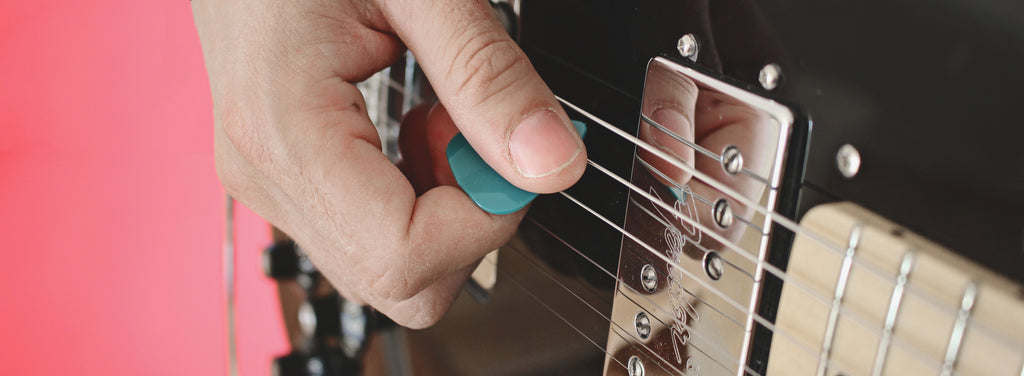
One thing that you need to keep in mind is that there are a lot of different types of plectrums available in the market and you should choose the one that works best for you. Once you have chosen the perfect pick, try to practice with it as much as possible.
We created a four-step guide to choosing your guitar pick, which you can find here:
https://rombopicks.com/blogs/insight-rombo/how-to-choose-the-right-guitar-pick
Brush it against the strings of your guitar so that your hands move easily and it produces a sound.
Another technique that you can use to hold a guitar pick in your hand is that you keep it in your dominant hand. This is the hand that you use the most, so it will be easier for you to keep the plectrum in it and play the guitar.
Some people prefer to play the guitar chords with the hand that they don’t use more often i.e non-dominant. So by holding the plectrum in your dominant hand and controlling the chords with no dominant one, you can easily brush the guitar strings and produce music.

Now place your one hand on the neck of the guitar and hold the plectrum between your index finger and thumb of the dominant hand. Keep in mind that the strings of your guitar are facing away from you. Keep the guitar on your knees, as for a beginner, it is easier to play the guitar while sitting. But in case you want to play standing up, you can use a shoulder strap so that it is easier for you to control.
Keep your hand steady but flexible. Steady because you need to hold the guitar plectrum and flexible because you need to keep brushing it over all of the strings.

A good sound will only be produced if you are moving your hands the right way. Keeping them too rigid will result in an unpleasant sound which no one likes to listen to. But once again, keep in mind that a good sound can only be produced after practice.

During the initial times, you only need to focus on getting your hands used to the guitar. So that it knows where the strings are, which chords to play and where to keep the plectrums. These are the basic skills that everyone needs to learn before officially starting out various tunes on the guitar.
For those more advanced guitarists looking to improve their guitar playing speed, click HERE.
Once you are in your comfortable position, rest your hand holding the plectrum on the strings of the guitar. Keep in mind that your hand should cover at least half of the plectrum. Some of the picks are made in a way that they are folded from one side to easily fit your index finger and your thumb on it.

Here you can find an example: Rombo Origami
Keep the grip of your hand as firm as possible but make sure it is easily movable so that once you start playing, you can brush the strings without making any extra effort. Never loosen your grip on the plectrum because it might fall off your hand while playing.
Now if you are a beginner, it is good that you are trying to get as much help as possible because this will help you in becoming a good guitarist within a minimum amount of time. By now, you do know how to carefully hold a plectrum (i.e between your index finger and thumb) now rest it over the strings.
Keep in mind that it should just lightly brush them so that only placing it there doesn’t produce any sound. The sound of your guitar must only be produced once you are moving the plectrum all over the strings.

One side of the strings is thin while the other one is thicker, practice on your guitar by gently moving your hand from the thicker side of the string to the thinner one. Although during the initial stages, rhythms produced would be rough but don’t worry about it. As you are only learning to hold the plectrum in the right way. There is a lot of time for learning guitar but prior to that, practicing is the most important thing that you need to do.
As this is the starting phase, try to practice as much as possible. As practicing will not only make your hand steady but it will also help you in maintaining your physical strength. The more your practice, the better you will be at playing guitar.
All successful guitarists need to play for hours in front of their audience and a person is only able to do that if he has done enough practicing.

So, in case you are taking more time trying to hold the guitar plectrum in the right way, tune the string or adjust the strap, don't worry about it. As all the great guitar players have started from this exact step so just polish your skills and you too will be an amazing guitarist really soon.
Note: There are many annoying things in life, but there’s nothing more annoying than losing a guitar pick you just had in your hand, and then realize that it has disappeared forever! - 4 Tips To Not Lose Your Guitar Picks
If your hands do an arduous job, then you must give them the right tools, right?
The material with which it is made can influence the definition of tone, attack, and flexibility. Therefore, without paying attention to it, you could hardly find your personal sound.
Are you curious about the materials used for the Rombo guitar picks?
Read a full article about it here:
https://rombopicks.com/blogs/insight-rombo/guitar-pick-materials-at-rombo
Sign up to get the latest on sales, new releases and more…
By signing up you agree to our privacy policy.
© 2025 ROMBO.
registered brand
Powered by Shopify